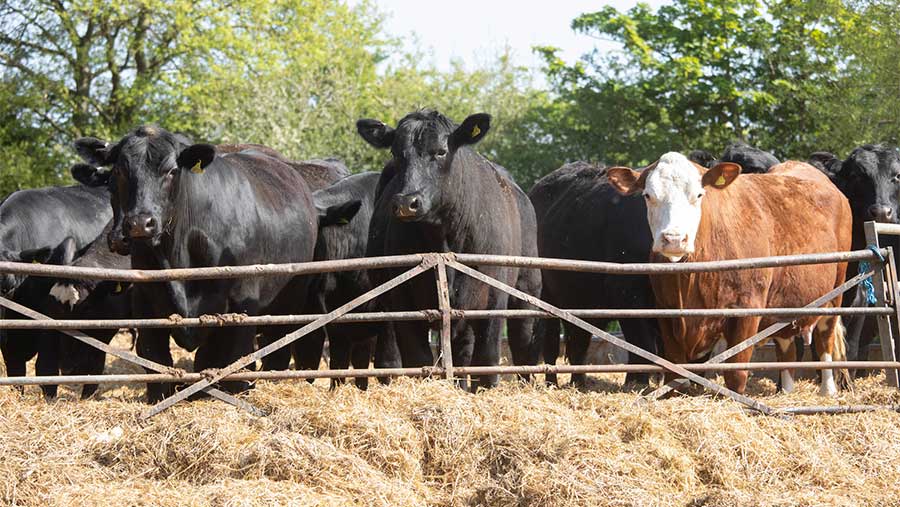Large loads of cattle make 520p/kg as carcass weights drop
 © Tim Scrivener
© Tim Scrivener Falling carcass weights have limited spring beef supply into abattoirs, maintaining pressure on procurement teams and meaning no let-up in the cattle bidding wars.
A 6.4kg drop in carcass weights on the year has nullified a small lift in cattle numbers, keeping overall beef supply very tight, according to Defra figures for the first four months of the year (see “Cattle throughputs and carcass weights for the first four months of the year”).
Levy boards forecast a 1.2% increase in domestic prime cattle volumes after British Cattle Movement Service data show an increase in 12- to 30-month-old cattle at the end of 2022.
Much of this was expected to be marketed in the first half of 2022.
As a result, finishers have seen base prices firm around the 500p/kg deadweight mark, with Farmers Weekly hearing of bids from 493-505p/kg deadweight, and larger loads at 510-520p/kg deadweight or more this week.
This is despite a cold and slow spring and several short weeks of bank holiday activities, which finishers say would be typically listed as excuses to pull prices.
Lighter carcasses
Carcass weights have lifted slightly on average since November 2022, when feed costs and forage scarcity combined to leave average weights at 340.3kg.
However, the average carcass this year has weighed 343.8kg, 3.78kg less than the five-year average.
This equates to about 450 fewer beef carcasses in a typical slaughter week of 40,000 head.
Finishers say lighter carcass weights could be due to a mix of factors, including:
- Rising market Many cattle, particularly longer-term stores bought in the autumn, have been traded in a rising market, so cattle are hitting profit sooner. Price per kilogram has been favoured over output a head
- Forage availability Forage-based steer and heifer systems may eke out forage and look to market cattle as early as possible after a dry and challenging forage summer in 2022
- Genetics A greater proportion of dairy-cross cattle and native breeds in the beef supply could limit carcass weights as fewer suckler-bred and continental cattle are produced
- Market high Strong beef prices give finishers little reason to hold on to cattle. Nervous finishers fear a drop in the beef price and procurement teams are desperate for cattle
- Mince demand Cow weights are also down, so feeding cows to lift them a carcass grade and improve cover and condition might seem unnecessary with the trade so strong.
Cattle throughputs and carcass weights for the first four months of the year |
||||
|
Category |
2020 |
2021 |
2022 |
2023 |
|
Prime cattle |
691,710 |
677,396 |
661,341 |
677,464 |
|
Prime carcass weight (kg) |
348.4 |
349 |
350.2 |
343.8 |
|
Total estimated supply (t) |
240,991 |
236,411 |
231,601 |
232,912 |
|
Cows/bulls (kg) |
214,992 |
200,854 |
197,400 |
205,180 |
|
Cow carcass weight (kg) |
310.9 |
314.7 |
311.7 |
308.4 |
|
Total estimated supply (t) |
66,841 |
63,208 |
61,529 |
63,277 |
|
Source: Defra |
||||
